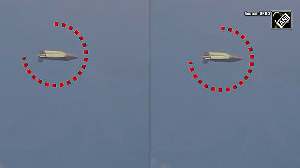Exactly two weeks after it was launched from Sriharikota, the spacecraft was in the last lap of its journey into the moon's orbit after it was injected into the lunar transfer trajectory by space scientists in a critical operation described by Indian Space Research Organisation as one of the "crucial and important milestones" in the Chandrayaan-1 mission.
"Chandrayaan-1 is being tracked by Spacecraft Control Centre at ISRO Telemetry, Tracking and Command Network (ISTRAC) in Bangalore. Today we have done the last orbit-raising manoeuvre to enter the lunar transfer trajectory. If everything goes right, by November 8, Chandrayaan-1 will start circling the moon," Nair told reporters in Ahmedabad.
Chandrayaan-1 entered the lunar transfer trajectory with an apogee (farthest point from earth) of about 380,000 km, the space agency said in a statement. "On Saturday evening, the lunar orbit insertion manoeuvres are planned to be carried out and the Chandrayaan will be captured in Moon's orbit," ISRO spokesperson S Satish told PTI in Bangalore.
During the crucial manoeuvre on Tuesday at 4.56 hrs, the spacecraft's 440 Newton liquid engine was fired for 145 seconds. Since its launch on October 22 by PSLV-C11, all systems onboard Chandrayaan-I spacecraft are performing normally, Nair said.
The ISRO statement said Chandrayaan-1 would approach the Moon on November 8, and the spacecraft's liquid engine would be fired again to insert the spacecraft into lunar orbit. It said the health of the spacecraft is being continuously monitored from the Spacecraft Control Centre at ISRO Telemetry, Tracking and Command Network here with the support from Indian Deep Space Network (IDSN) antennas at Byalalu on the outskirts of Bangalore.
ISRO said since the launch on October 22 by PSLV-C11, all systems onboard Chandrayaan-1 are performing normally. Once the spacecraft is in the lunar orbit, it will stabilise in about a week after which it will send a probe instrument to the moon's surface. Chandrayaan-1 carries 11 payloads -- five from India and others from abroad. During a two-year orbital mission, it will provide a detailed map of the mineral, chemical and topographical characteristics of the lunar surface.
When asked by newsmen how long will it take for a man to step on moon, Nair said that India still has a long way to go. "We have to first develop our own technology to send man to the outer space and then to the moon. We still have a very long way to go. If funding and everything is available, by 2015 we will have capabilities to send man to the outer space. From then it will take 5-6 years to send a man to moon," Nair said.







 © 2025
© 2025